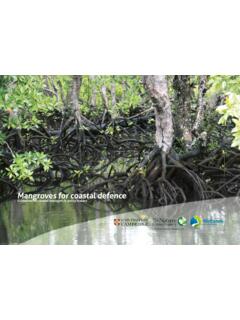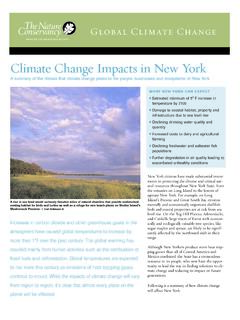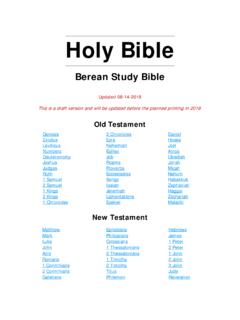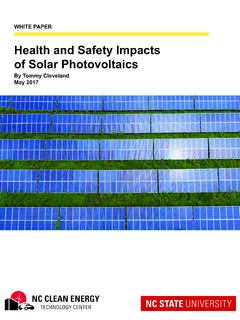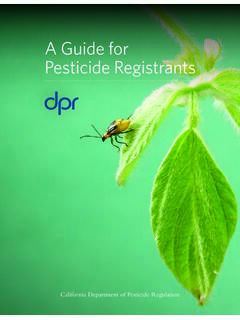Transcription of Where Does California’s Water Come From?
1 Where Does California s Water Come From? Land conservation and the watersheds that supply California s drinking Water The Nature Conservancy of California October 2012 Version Where Does California s Water Come From? October 2012 The Nature Conservancy 2 Where Does California s Water Come From?
2 Land conservation and the watersheds that supply California s drinking Water A Science for Conservation Technical Brief October 2012 Version Kirk Klausmeyer Katherine Fitzgerald The Nature Conservancy of California 201 Mission Street, 4th Floor San Francisco, CA 94105 Cover maps: Surface drinking Water sources for Fresno, Los Angeles, San Francisco and Inland Empire Cities. See Appendix A for full maps. Recommended Citation: Klausmeyer K. and K. Fitzgerald. 2012. Where does California s Water come from?
3 Land conservation and the watersheds that supply California s drinking Water . A Science for Conservation Technical Brief. An unpublished report of The Nature Conservancy. San Francisco, CA. 13 pages + Appendices. Where Does California s Water Come From? October 2012 The Nature Conservancy 3 Summary Ninety-three percent of Californians rely on publicly supplied Water to meet their domestic Water needs.
4 Eighty-two percent of the Water supplied by public Water districts for domestic and other uses come from rivers, lakes, reservoirs, and other surface Water sources (Kenny et al. 2009). The quality of the Water flowing into these sources is directly affected by the condition of the land in the surrounding watershed (Lenat and Crawford 1994, Gutman 2007). Better quality Water generally translates to lower filtration and treatment costs for the utilities who deliver Water to homes and businesses. Despite the importance of watershed conditions for California s drinking Water supply, there is currently no comprehensive database that maps the full extent and condition of those watersheds.
5 Using public sources of data, we mapped the surface drinking Water sources (rivers, reservoirs, lakes, etc.) for 30 million (80%) of California s residents and the watersheds that supply Water to those sources. We found that California s drinking Water supply system relies on approximately 157 million acres of land spanning 8 states to collect, filter, and deliver Water . Only 16% of this land is strictly protected from development and degradation ( , wilderness areas, national parks). Roughly half of the land (51%) has some level of protection but designated for multiple uses including significant landscape-disturbing activities like logging, road building, and mining.
6 The remaining 33% is in private ownership with highly variable levels of protection from development and degradation. In fact, million acres (5%) of the watersheds supplying California s drinking Water have been converted to agricultural uses and an additional million acres (2%) has been converted to urban and suburban development. The sizes of the watersheds supplying drinking Water for individual cities range from 57,000 acres (San Bernardino) to 146,000,000 acres (Los Angeles). For some cities, the watersheds are very well protected ( , Fresno has 89% with some level of protection); while for other cities there are few known protections in place ( Santa Rosa has 80% with no recorded protections).
7 Mapping the watersheds that supply drinking Water is important to highlight areas Where land-use protections and habitat restoration may be needed or Where management practices are especially important. Increasing conservation action in unprotected The Watersheds Supplying California s Drinking Water Total land area (acres) 156,623,659 Land in public management 67% Land in private ownership 33% Land used for agriculture 5% Land in urban/suburban development 2% Where Does California s Water Come From?
8 October 2012 The Nature Conservancy 4 watersheds could protect and in some cases improve drinking Water quality, reducing the need for costly and energy intensive filtration and treatment facilities. Introduction A watershed is an area of land that contributes Water to a given location, such as a reservoir, a confluence of two streams, or the ocean.
9 Within a watershed, Water from rain or snow flows down the slope, through the soil, or via groundwater flow and usually by a combination of these routes to reach the stream and contribute to the flow of the stream. Watersheds are important sources of drinking Water , as well as a habitat for many aquatic species. Healthy watersheds with intact native vegetation and wetlands provide important functions such as Water purification, flood control , nutrient recycling, and groundwater recharge. Such valuable functions are sometimes referred to as ecosystem services (Revenga et al.)
10 1998). Californians rely on both surface and ground Water sources for their domestic Water supply. Unfortunately, the watersheds that yield Water to these sources face many sources of degradation including sedimentation and pollution from residential and industrial development, timber harvests, agricultural production, land clearing, and mining (Revenga et al. 1998, Bolund and Hunhammar 1999). While these types of degradation can affect both surface and groundwater, this report focuses on surface drinking Water sources and watersheds.






